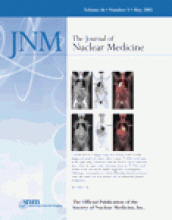Abstract
With the advantages of the increased sensitivity of fully 3-dimensional (3D) PET for whole-body imaging come the challenges of more complicated quantitative corrections and, in particular, an increase in the number of random coincidences. The most common method of correcting for random coincidences is the real-time subtraction of a delayed coincidence channel, which does not add bias but increases noise. An alternative approach is the postacquisition subtraction of a low-noise random coincidence estimate, which can be obtained either from a smoothed delayed coincidence sinogram or from a calibration scan or directly estimated. Each method makes different trade-offs between noise amplification, bias, and data-processing requirements. These trade-offs are dependent on activity injected, the local imaging environment (e.g., near the bladder), and the reconstruction algorithm. Methods: Using fully 3D whole-body simulations and phantom studies, we investigate how the gains in noise equivalent count (NEC) rates from using a noiseless random coincidence estimation method are translated to improvements in image signal-to-noise ratio (SNR). The image SNR, however, depends on the image reconstruction method and the local imaging environment. Results: We show that for fully 3D whole-body imaging using a particular set of scanners and clinical protocols, a low-noise estimate of random coincidences improves sinogram and image SNRs by approximately 15% compared with online subtraction of delayed coincidences. Conclusion: A 15% improvement in image SNR arises from a 32% increase in the NEC rate. Thus, scan duration can be reduced by 25% while still maintaining a constant total acquired NEC.
Footnotes
Received Apr. 22, 2004; revision accepted Dec. 28, 2004.
For correspondence or reprints contact: Paul E. Kinahan, PhD, University of Washington Medical Center, Box 356004, 1959 N.E. Pacific St., Seattle, WA 98195-6004.
E-mail: kinahan{at}u.washington.edu







